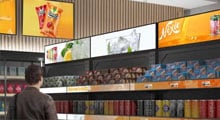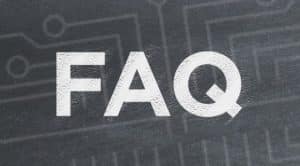Radio frequency identification (RFID) was once an emerging innovation—now it’s a foundational technology across logistics, retail, and supply chain management. As RFID technology has evolved, it has become more cost-effective, more scalable, and far more versatile. Today, RFID-enabled systems play a key role in inventory management, healthcare, transportation, and more.
We understand that exploring new technologies can feel overwhelming. This FAQ answers the most frequently asked questions about RFID to help you understand how RFID works, its benefits, and how to use RFID effectively in your business.
What is RFID?
RFID stands for radio frequency identification—a system that uses radio waves to locate and track objects wirelessly. It eliminates the need for line of sight, unlike barcode scanning, and allows data collection in real-time.
How does RFID work?
RFID systems use electromagnetic fields to transmit data. These signals are sent between RFID readers, antenna, and RFID tags, which contain microchips. The RFID reader detects the tag via its antenna and converts the radio signal into usable data, which is processed through middleware into enterprise systems like ERP.
What are RFID tags?
An RFID tag consists of a microchip and antenna embedded in a label or object. It stores data and communicates with the RFID reader using radio waves. RFID tagging means attaching these tags to items to track their movement or status throughout a process or location.
There are two primary types of RFID tags:
- Passive RFID tags: These do not have a battery and rely on the reader’s signal to power data transmission.
- Active tags: These include an internal battery that allows them to broadcast signals continuously, enabling a longer read range and greater data capacity.
The main difference between the two are that Active tags send signals on their own, while passive tags must be powered by the RFID reader.
What are the real-world benefits of RFID?
The benefits of RFID over traditional systems like barcode labels include:
- Real-time visibility for better inventory management
- Reduced labor costs and errors
- Faster data collection
- Improved asset tracking
- Support for RFID applications in complex environments like metal surfaces or liquids
- Enhanced traceability across the supply chain
RFID is also used in healthcare for patient tracking, retail for product tagging, and transportation for toll collection.
What are the different RFID frequencies?
RFID systems operate on several frequencies depending on the application:
- Low Frequency (LF): 125–134 kHz. Works well near metal surfaces and is used for animal tagging.
- High Frequency (HF): 13.56 MHz. Common in payment systems and access control.
- Ultra High Frequency (UHF): 860–960 MHz. Offers longer read ranges and faster data transfer—ideal for inventory and pallet tracking.
- Super High Frequency (SHF): 2.45 or 5.8 GHz. Used in specialized long-range RFID solutions, but more costly.
Understanding the role of RFID frequency helps businesses choose the right system for their needs.
Is RFID reliable?
Yes—RFID is highly reliable when configured properly. With the right RFID standards, tags, and reader placement, even challenging environments (like those with metal surfaces or liquids) can be managed using specialized tags like transponders or ROM (RFID on metal) tags.
How much do RFID tags cost?
RFID tag pricing varies based on type, frequency, and application. Passive RFID tags can cost as little as a few cents each, while active tags with batteries are more expensive. Custom solutions or RFID-enabled tracking on assets like pallets or containers may require higher investment but offer long-term ROI.
Where is RFID commonly used?
RFID applications span many industries:
- Inventory management: Asset and inventory tracking, real-time shipment visibility
- Healthcare: Patient ID bands, equipment tracking
- Retail: RFID labels on products, anti-theft systems
- Manufacturing: Tool and parts tracking
- Hospitality and access control: Key cards and wristbands
Businesses use RFID for functionality like monitoring conditions (e.g., temperature) or automating repetitive processes.
How to track items using RFID?
You track using RFID by placing tags on items and installing RFID readers in key locations. Tags transmit data about the item’s identity, location, and status. Readers relay that data to your systems, allowing for efficient tracking throughout your operations.
RFID vs. Barcodes: How does RFID differ from barcodes?
While both technologies support tracking and data capture, RFID offers key advantages over traditional barcode labels:
RFID:
- Doesn’t require line of sight — tags can be scanned through packaging or materials.
- Reads multiple items simultaneously, making it ideal for bulk inventory management and supply chain operations.
- Offers longer read ranges, especially with ultra high frequency (UHF) systems.
- Performs better in challenging environments like metal surfaces or areas with high moisture.
- Stores more data with embedded microchips and transponders.
- Enables real-time visibility and automation with RFID-enabled systems.
Barcodes:
- Require a direct line of sight and must be scanned one at a time.
- Are more prone to damage and limited by physical size.
- Offer minimal data capacity, best suited for simple tracking needs.
RFID technology is more flexible, scalable, and efficient than barcodes—especially in fast-paced or complex environments.
What are RFID systems made of?
RFID systems include:
- Tags: Attached to items
- Readers: Collect data
- Antenna: Transmit and receive signals
- Middleware: Integrate RFID data into business systems
- Optional: Mobile or fixed readers depending on your facility layout
How to implement RFID?
Implementing RFID solutions starts with reviewing your existing data tracking and layout. Choose:
- The right tag type (active vs passive)
- Frequency (LF, HF, UHF, SHF)
- Reader style (fixed or mobile)
A partner like Peak Technologies can help design and deploy RFID systems tailored to your business goals and operational environment.
Where do you place RFID readers?
RFID readers are placed where data capture is most valuable:
- Entry/exit points (e.g., loading docks)
- Warehouses and retail backrooms
- Mounted on forklifts or used as handheld devices
Proper placement ensures optimal signal capture and data flow.
Does RFID work on metal or with liquids?
While metal surfaces and liquids can affect signal transmission, modern RFID systems include specialized RFID tags, such as transponders or flag tags, designed to function in these environments.
What information do RFID tags capture?
Tags can capture and store various types of data, such as:
- Product identifier and location (each time a reader scans the tag, the system logs that reader’s position and timestamp to track where the item is)
- Temperature and environmental data
- Timestamped events like check-ins or shipments
- Access permissions
- Maintenance records and service history
This versatility enables powerful RFID applications across industries.
What are the levels of RFID tagging?
Tagging can occur at:
- Item level: Tag individual units
- Pallet or case level: One tag per pallet, tracking grouped items
Both are used in modern supply chain management for different stages of logistics and handling.
FAQs About RFID
Frequently asked questions about RFID cover everything from cost to capabilities. Whether you’re asking “How does RFID work?” or exploring types of RFID systems, understanding the answers is key to successful adoption.
Still have RFID questions? Our experts at Peak Technologies are here to help you understand the best way to use RFID in your operations.
Embrace RFID for a Smarter Future
RFID is more than a trend—it’s a game-changing technology with measurable impact. With the right strategy, you can future-proof your operations and streamline your supply chain.
Peak Technologies can guide your RFID journey from planning to full implementation. Let us help you unlock the potential of RFID technology with tailored solutions for your business. Contact us today to get started.


























